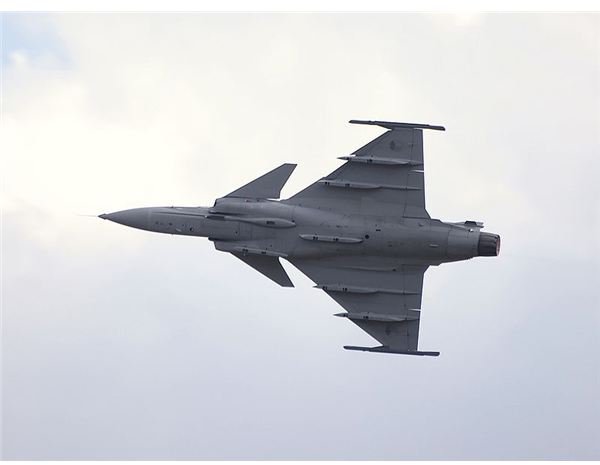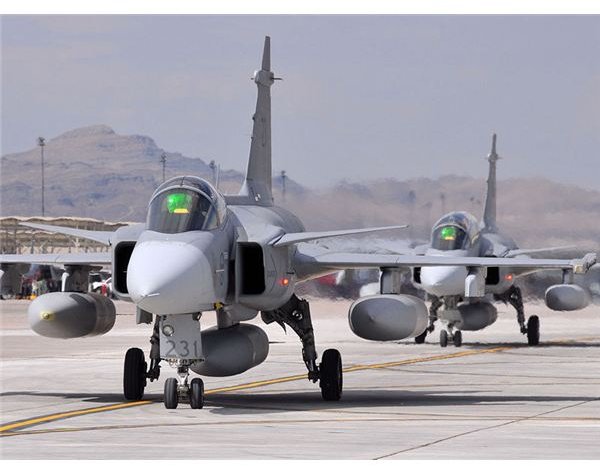The Saab JAS 39 Gripen Fighter Jet: Sweden's Finest Fighter
Sweden’s Newest Indigenous Fighter Jet
A highly maneuverable multirole aircraft, the Saab JAS 39 Gripen fighter is a unique design indigenous to Sweden. The successor to both the Draken and Viggen combat aircraft, the Gripen exceeds both in terms of maneuverability, lethality, and the ability to perform multiple roles in combat. The JAS designation stands for Jakt, Attack, and Spaning in Swedish, which roughly translates to Air-to-air, ground attack, and reconnaissance in English - a designation that fully encompasses the intended variety in the combat missions the Gripen can support.
The first of the 4.5 generation fighters to enter operational service, the aircraft has set a number of standards that other contemporary fighters including the Dassault Rafale and Eurofighter Typhoon have incorporated into their design. Fully digitized heads up displays, a centerline control stick and left hand throttle position, and an overall attempt to make the entire machine-human interaction process more efficient and intuitive serve to reduce pilot attention spent flying the jet and more attention paid to situational awareness.
Of course the Gripen’s status as an early entry into the advanced fighter market means that early Gripens are inherently less technologically advanced when compared to their European competitors, which have taken advantage of a few more years of technological advancement to refine their avionics. But Saab has been working continuously on updates to the aircraft that will keep it current with advancements in computer technology and precision oriented weapons systems in addition to new air to air missiles.
JAS 39 Gripen Fighter Aircraft Historical Context
JAS 39 Gripen aircraft grew out of a Swedish Air Force requirement to replace the aging Saab Viggen and Draken combat aircraft, which were designed in the 1960’s and in service for over twenty years. During the height of the Cold War the Swedish military had concerns that any war in Europe would be accompanied by a Warsaw Pact nations attempt to secure their northern flank in Scandinavia. Because of the sheer power of the military forces of the Soviet Union that could be expected to crush Swedish military concentrations in the early hours of a conflict, Swedish strategy involved dispersing aviation assets across the country, ensuring a retaliatory capacity even in the event of a devastating surprise attack or major losses in an ongoing battle of attrition.
The Gripen fighter jet force was required to be capable of dispersing across the whole of Sweden, utilizing pre-positioned fuel and weapons stores scattered around Swedish territory and operating from short, unprepared surfaces like roads and highways. The Gripen was designed to be able to be refueled and rearmed by a team of technicians operating out of a truck, then go out on a combat mission to defend Swedish territory from invasion.
This innate expeditionary capability is serving the Gripen well in the post Cold War era defense markets, where many nations want a fighter with low maintenance overhead and the ability to deploy into less technologically advanced parts of the world without difficulty.
Gripen Operational Capabilities
- Close to 46 feet long and 15 feet high with a 27.5 foot wingspan
- Mach 2.0 top speed, supersonic capability at any altitude
- Empty weight of 6 tons, loaded 9 tons, max takeoff weight 15.5 tons
- 1 afterburning engine with 6 tons of thrust, 9 on afterburner
- 50 thousand foot service ceiling, 500 mile combat radius
- Less than 70 lbs per foot squared wing loading, .97 thrust to weight ratio
- 1 internal 27mm Mauser cannon with 120 rounds
- Up to six air to air missiles, two cruise missiles, or four smart bombs
- Electronic countermeasures pod

The Gripen is extremely maneuverable, sporting a delta winged design that is supplemented by canard foreplanes to add maneuverability. The Gripen’s wing loading allows for some of the tightest turns made made by any contemporary fighter, and it is used as test pilot training platform by the United Kingdom’s Royal Air Force.
Indeed the jet’s small size, high maneuverability, and inherent ruggedness makes it a very different animal than any competing Gen 4.5 fighter out there. Only the Russians have placed such an emphasis on aircraft that can operate from unprepared runways in an emergency and designed aircraft like the MiG-29 and MiG-35 Fulcrum series to handle such eventualities. Because of the long standing concerns about having too strong of political ties to Russia or America among many traditionally neutral nations, the Gripen may end up being an ideal fighter for small and non-aligned nations like Switzerland, Brazil, India, and Indonesia.
Gripen - the Future for India or Brazil?
The India M-MRCA competition for a tender of over a hundred modern fighters has seen the Gripen pitted against the MiG-35 Fulcrum, Eurofighter Typhoon, Dassault Rafale, Boeing F-18E Super Hornet, and an updated version of the F-16 Fighting Falcon. The JAS 39 Gripen variant marketed to India reportedly performed well in even extremely high altitude tests, and is well liked for its reliability record. If the fighter had a weakness in the Indian M-MRCA fighter competition, it was its relatively short range - a significant consideration to a large nation like India. However, the Gripen is apparently being considered for a separate Indian project to purchase a next generation naval fighter for India’s future aircraft carriers. A navalized version of the Gripen has not been deployed yet, but the aircraft’s small size and durability bodes well for the success of a navalized variant.
Unfortunately for Saab, in 2011 it was confirmed that the Eurofighter and Rafale made the shortlist for the M-MRCA contract, and the Gripen fighter had lost out to its European competitors. Though India’s government has not publicly disclosed the details behind its selection, a probable component is the reported difficulty that the Gripen had in starting its original engines at the very high altitudes that dominate much of the Indian frontier. It has been rumored that special engines needed to be flown into India to re-equip the demonstrator aircraft, which may well have contributed to its decision even though the replacements performed well.
Brazil is another potential Gripen fighter customer, and it is rumored that the Gripen was the preferred option of the Brazilian military during a competition with the F-18E Super Hornet and Dassault Rafale fighter jets to replace older Brazilian jets currently in service. However, statements by French president Sarkozy indicate that the Rafale has been chosen as part of a wider military technology export deal, so the true status of a Brazilian Gripen purchase is unknown.
Regardless of the outcomes of the Brazilian and Indian competitions, the jet is seen as a worldwide contender for many nations’ future fighter needs, and is even seen in some markets as the perfect complement to the expensive, high tech Eurofighter.
Other Operators and Export Targets
Gripens have also been discussed as a potential next generation multirole combat aircraft by a variety of smaller air forces whose current fleet of aircraft - often old F5 Tiger IIs, F-16 Fighting Falcons, or MiG 21 Fishbeds - are based on dated technology and are rapidly becoming unsafe to fly. Bulgaria, Slovakia, Denmark, Croatia, Switzerland, and the Netherlands are all considering purchasing the JAS 39 Gripen aircraft to replace old fighters, which interestingly enough has brought the Gripen into competition with another modern aircraft whose future and capabilities are increasingly uncertain. This fighter is the Lockheed F-35 Lightning II - the result of the Joint Strike Fighter design process.
Because of fears of cost overruns and reports that the F-35 is not highly capable in the air to air role, the Saab jet is being floated as a possible alternative due to its proven ruggedness and cost effectiveness. Gripens have been exported to the Czech Republic, Hungary, and South Africa - and Thailand has also signed a contract that will transfer a number of Gripen fighters to the Royal Thai Air Force. The JAS 39 Gripen is proving popular with smaller air forces that are traditionally defense oriented and who are rightfully concerned with the high costs normally associated with purchasing and maintaining advanced combat aircraft.
This is a sensible choice, as a fighter meant to operate individually from unprepared stretches of highway must be inherently robust and simple. Many air forces lack the infrastructure to maintain large and complex fleets of aircraft, so a maintenance-light aircraft can well be ideal.
JAS 39 Gripen Fighter Aircraft Parting Thoughts
The Gripen fighter is a unique entry in the generation 4.5 combat aircraft market. While not as technologically advanced as the Typhoon or capable of carrying as heavy a combat load as the Rafale, the Gripen’s superb maneuverability, purchase cost, and operational costs in conjunction with its expeditionary capabilities have made it the fighter of choice for air forces around the world.
Gripen International Technical Summary
https://www.gripen.com/en/GripenFighter/TechnicalSummary.htm
Royal Thai Air Force Press Release for Purchase of JAS 39 Gripen Fighters
https://www.rtaf.mi.th/news/n07/gripen/080213_PurchaseAgreement_en.pdf
Swedish Air Force - Gripen Milestones
https://www.fmv.se/WmTemplates/page.aspx?id=1408
References and Image Sources
Gripen International Technical Summary, https://www.gripen.com/en/GripenFighter/TechnicalSummary.htm
Royal Thai Air Force Press Release for Purchase of JAS 39 Gripen Fighters, https://www.rtaf.mi.th/news/n07/gripen/080213_PurchaseAgreement_en.pdf
Swedish Air Force - Gripen Milestones, https://www.fmv.se/WmTemplates/page.aspx?id=1408
This post is part of the series: The Saab Gripen Fighter: Multiple Variants and Export Oriented
The JAS 39 Gripen by Saab was one of the first generation 4+ combat aircraft, and since its debut it has proven to be a highly cost effective lightweight fighter. In the service of several air forces including its native Sweden, major next generation aircraft competitions feature the Gripen
